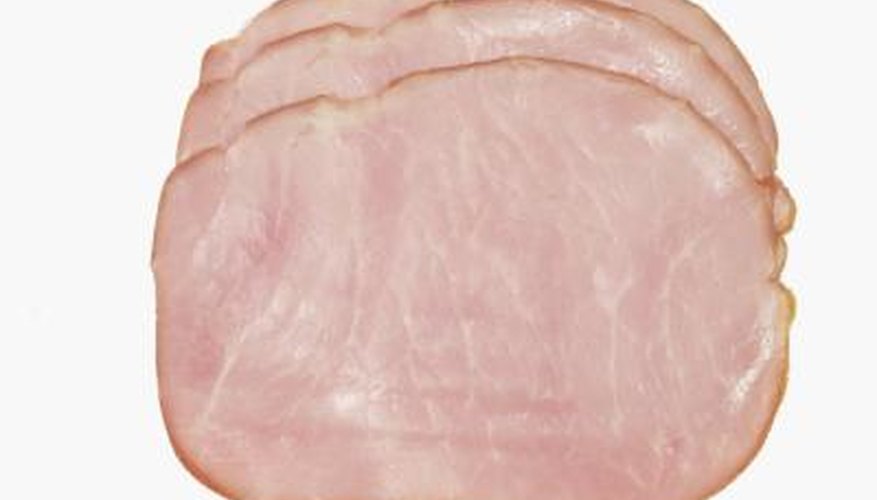Ham that is stored at temperatures above 4.44 degrees Celsius or kept past its expiration date can grow bacteria that may cause food poisoning. The ideal storage temperature for ham is 00 degrees Celsius. Track the date when you bought the ham so you'll have an idea if the meat is still good. A cooked ham generally lasts three to four days in the refrigerator. If in doubt, look for signs that the meat has spoiled.
Odour
Ham that has spoiled sometimes emits a foul-smelling odour. The odour can resemble ammonia or sulphur, but stay conscious of any off-putting smell. The smell is caused by the ham's enzymes, proteins and fats breaking down. The smell can also be caused by growing bacteria, mould or yeast. Sometimes a spoiling ham will give off an immediately apparent odour. If the meat has been in the refrigerator for a couple of days, hold it close to your nose to be sure it smells as a ham should.
- Ham that has spoiled sometimes emits a foul-smelling odour.
- Sometimes a spoiling ham will give off an immediately apparent odour.
Slime
Ham that is growing mould, yeast or bacteria can feel sticky or slimy. The growth can appear as a clear, sticky substance covering the meat. Often you can see that the meat appears slimy without touching it. If you do touch the meat, be sure to wash your hands afterward so that you avoid spreading bacteria. Try to differentiate between slime and what is often a normal, nonsticky shine. Minerals in ham cause the shine, according to the Federal Citizen Information Center.
- Ham that is growing mould, yeast or bacteria can feel sticky or slimy.
- If you do touch the meat, be sure to wash your hands afterward so that you avoid spreading bacteria.
Discolouration
Ham that has spoiled can turn a variety of colours, ranging from white to black to green to grey. Most of the colours indicate that mould has begun to grow on the meat. Sometimes, ham turns brown or grey as a result of proteins breaking down. In their normal state, hams appear brightly coloured with a pinkish-grey hue. Sometimes hams can appear pale pink, but the pale colour doesn't indicate bacteria growth. Instead, it simply means that the ham contains a lot of water.
- Ham that has spoiled can turn a variety of colours, ranging from white to black to green to grey.
- Sometimes hams can appear pale pink, but the pale colour doesn't indicate bacteria growth.
No Sign
Ham can appear normal yet host bacteria that can cause food poisoning, according to Purdue University. Cooking, handling and storing ham properly is important to prevent bacteria growth. Cooking ham to 71.1 degrees Celsius kills the harmful substances sometimes found in hams, such as Trichinella spiralis, a parasite specific to hogs. Avoid eating ham if it wasn't cooked thoroughly. Also avoid eating ham that wasn't wrapped tightly while in the refrigerator since invisible bacteria may be present.
- Ham can appear normal yet host bacteria that can cause food poisoning, according to Purdue University.
- Cooking ham to 71.1 degrees Celsius kills the harmful substances sometimes found in hams, such as Trichinella spiralis, a parasite specific to hogs.
